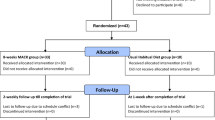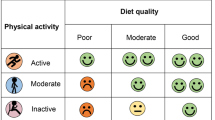Abstract
NAFLD encompasses a spectrum of liver diseases pertaining to fat accumulation in the liver in the absence of significant alcohol consumption. NASH is the most clinically relevant subset of NAFLD, and patients with NASH have an increased risk of progression to cirrhosis or developing liver cancer. No pharmacotherapy is currently approved for NAFLD, and lifestyle modification via diet and exercise is most commonly recommended. The optimal physical activity regimen in terms of both effectiveness and compliance remains to be determined and is the focus of this Review.
Key Points
-
Lifestyle modification via increased physical activity is beneficial in patients with NAFLD
-
Although weight loss has been shown to produce improvement in biochemical and histological markers of NAFLD, exercise might improve hepatic steatosis and steatohepatitis even in the absence of major weight loss
-
Cardiovascular and resistance training both seem to benefit patients with NAFLD; further study is needed to determine if one is more effective than the other
-
A reduction in sedentary time in the absence of increased intense physical activity might also improve NAFLD, although more research is required
This is a preview of subscription content, access via your institution
Access options
Subscribe to this journal
Receive 12 print issues and online access
$209.00 per year
only $17.42 per issue
Buy this article
- Purchase on Springer Link
- Instant access to full article PDF
Prices may be subject to local taxes which are calculated during checkout

Similar content being viewed by others
References
Chalasani, N. et al. The diagnosis and management of non-alcoholic fatty liver disease: practice Guideline by the American Association for the Study of Liver Diseases, American College of Gastroenterology, and the American Gastroenterological Association. Hepatology 55, 2005–2023 (2012).
Torres, D. M., Williams, C. D. & Harrison, S. A. Features, diagnosis, and treatment of nonalcholic fatty liver disease. Clin. Gastroenterol. Hepatol. 10, 837–858 (2012).
Bell, B. P. et al. The epidemiology of newly diagnosed chronic liver disease in gastroenterology practices in the Unites States: results from population-based surveillance. Am. J. Gastroenterol. 103, 2727–2736 (2008).
Williams, C. D. et al. Prevalence of nonalcoholic fatty liver disease and nonalcoholic steatohepatitis among a largely middle-aged population utilizing ultrasound and liver biopsy: a prospective study. Gastroenterology 140, 124–131 (2011).
Hallsworth, K. et al. Resistance exercise reduces liver fat and its mediators in non-alcoholic fatty liver disease independent of weight loss. Gut 60, 1278–1283 (2011).
Palmer, M. & Schaffner, F. Effect of weight reduction on hepatic abnormalities in overweight patients. Gastroenterology 99, 1408–1413 (1990).
Zelber-Sagi, S. et al. A double-blind randomized placebo controlled trial of orlistat for treatment of nonalcoholic fatty liver disease. Clin. Gastroenterol. Hepatol. 4, 639–644 (2006).
Harrison, S. A., Fecht, W., Brunt, E. M. & Neuschwander-Tetri, B. A. Orlistat for overweight subjects with nonalcoholic steatohepatitis: a randomized prospective trial. Hepatology 49, 80–86 (2009).
Kirk, E. et al. Dietary fat and carbohydrates differentially alter insulin sensitivity during caloric restriction. Gastroenterology 136, 1552–1560 (2009).
Sreenivasa Baba, C. et al. Effect of exercise and dietary modification on serum aminotransferase levels in patients with nonalcoholic steatohepatitis. J. Gastroenterol. Hepatol. 21 (1 Pt 1), 191–198 (2006).
Lazo, M. et al. Effect of a 12-month intensive lifestyle intervention on hepatic steatosis in adults with type 2 diabetes. Diabetes Care 33, 2156–2163 (2010).
Promrat, K. et al. Randomized control trial testing the effect of weight loss on nonalcoholic steatohepatitis. Hepatology 51, 121–129 (2010).
Kistler, K. D. et al. Physical activity recommendations, exercise intensity, and histological severity of nonalcoholic fatty liver disease. Am. J. Gastroenterol. 106, 460–468 (2011).
Zelber-Sagi, S. et al. Role of leisure-time activity in nonalcoholic fatty liver disease: a population-based study. Hepatology 48, 1791–1798 (2009).
Hattar, L., Wilson, T. A., Tabotabo, L. A. & Abrams, S. H. Physical activity and nutrition attitudes in obese Hispanic children with non-alcoholic steatohepatitis. World J. Gastroenterol. 17, 4396–4403 (2011).
Fealy, C. E. et al. Short-term exercise reduces markers of hepatocyte apoptosis in nonalcoholic fatty liver disease. J. Appl. Physiol. 113, 1–6 (2012).
Keating, S. E., Hackett, D. A., George, J. & Johnson, N. A. Exercise and non-alcoholic fatty liver disease: a systematic review and meta-analysis. J. Hepatol. 57, 157–166 (2012).
Van der Ploeg, H. P., Chey, T., Korda, R. J., Banks, E. & Bauman, A. Sitting time and all-cause mortality in 222,497 Australian adults. Arch. Intern. Med. 172, 494–500 (2012).
Dunstan, D. W. et al. Breaking up prolonged sitting reduces postprandial glucose and insulin responses. Diabetes Care 35, 976–983 (2012).
Sullivan, S., Kirk, E. P., Mittendorfer, B., Patterson, B. W. & Klein, S. Randomized trial of exercise effect on intrahepatic triglyceride content and lipid kinetics in nonalcoholic fatty liver disease. Hepatology 55, 1738–1745 (2012).
Johnson, N. A. et al. Aerobic exercise training reduces hepatic and visceral lipids in obese individuals without weight loss. Hepatology 50, 1105–1112 (2009).
Kantartzis, K. et al. High cardiorespiratory fitness is an independent predictor of the reduction in liver fat during a lifestyle intervention in non-alcoholic fatty liver disease. Gut 58, 1281–1288 (2009).
Kawaguchi, T. et al. Hybrid training of voluntary and electrical muscle contractions reduces steatosis, insulin resistance, and IL-6 levels in patients with NAFLD: a pilot study. J. Gastroenterol. 46, 746–757 (2011).
Strasser, B., Siebert, U. & Schobersberger, W. Resistance training in the treatment of metabolic syndrome: a systematic review and meta-analysis of the effect of resistance training on metabolic clustering in patients with abnormal glucose metabolism. Sports Med. 40, 397–415 (2010).
Strasser, B., Arvandi, M. & Siebert, U. Resistance training, visceral obesity and inflammatory response: a review of the evidence. Obes. Rev. 13, 578–591 (2012).
Acknowledgements
The view(s) expressed herein are those of the author(s) and do not reflect the official policy or position of Brooke Army Medical Center, the US Army Medical Department, the US Army Office of the Surgeon General, the Department of the Army, Department of Defense or the US Government.
Author information
Authors and Affiliations
Contributions
All authors contributed equally to all aspects of this manuscript.
Corresponding author
Ethics declarations
Competing interests
The authors declare no competing financial interests.
Rights and permissions
About this article
Cite this article
Rodriguez, B., Torres, D. & Harrison, S. Physical activity: an essential component of lifestyle modification in NAFLD. Nat Rev Gastroenterol Hepatol 9, 726–731 (2012). https://doi.org/10.1038/nrgastro.2012.200
Published:
Issue Date:
DOI: https://doi.org/10.1038/nrgastro.2012.200
This article is cited by
-
EASL–EASD–EASO Clinical Practice Guidelines for the management of non-alcoholic fatty liver disease
Diabetologia (2016)
-
Effects of physical activity upon the liver
European Journal of Applied Physiology (2015)
-
Hepatic Steatosis and Steatohepatitis: Are they Really Two Distinct Entities?
Current Hepatology Reports (2014)
-
Genetic and Epigenetic Associations with NAFLD: Focus on Clinical Decision Making and Novel Concepts in Disease Pathogenesis
Current Hepatology Reports (2014)
-
Voluntary exercise under a food restriction condition decreases blood branched-chain amino acid levels, in addition to improvement of glucose and lipid metabolism, in db mice, animal model of type 2 diabetes
Environmental Health and Preventive Medicine (2014)



